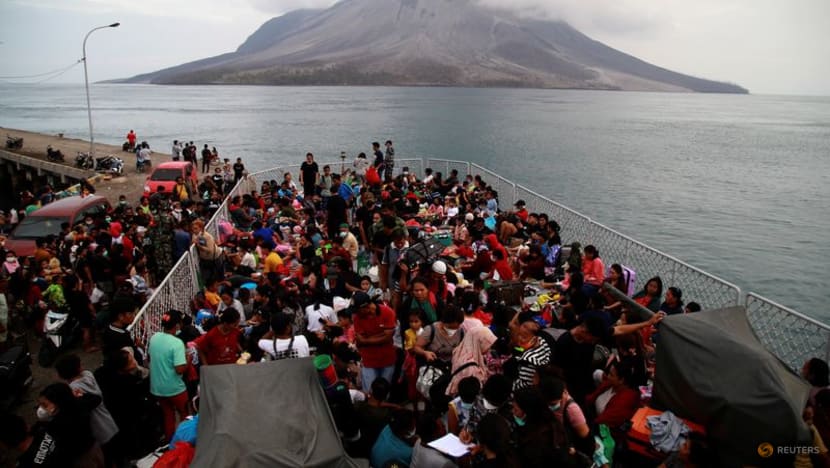Indonesia's Mount Ruang eruptions unlikely to trigger tsunami, but ...
JAKARTA: The latest eruptions from Indonesia’s Mount Ruang volcano have led authorities to issue a tsunami warning to those living near the remote island, though experts have cast doubts whether such an event could occur due to the type of volcanic activities that have happened thus far.

Mount Ruang - which is located in a remote part of the Celebes Sea - first erupted on Apr 16, forcing more than 830 residents on Ruang Island to be evacuated. They are part of the estimated 11,000 to 12,000 people that are to be evacuated from near Mount Ruang’s crater, according to the country’s national disaster agency, though some have since returned to their homes.
It was unclear how many residents had gone back and how many were forced to evacuate once more, AFP reported.
Following the initial eruption, the threat level of the volcanic activities was lowered to level three before it was subsequently raised again to its highest level after another series of eruptions earlier this week.
Mr Hendra Gunawan, head of the Center for Volcanology and Geological Hazard Mitigation, said that the increase in Mount Ruang eruptions is due to the recent earthquake activities in the area.
"There were 15 cluster earthquakes, 237 shallow volcanic earthquakes, 425 deep volcanic earthquakes, 15 local tectonic earthquakes, and six distant tectonic earthquakes," Mr Hendra said in a statement quoted by Kompas on Tuesday (Apr 30).
Given the increase in Mount Ruang's eruption activities, Indonesia's National Disaster Management Agency (BNPB) has warned of a potential tsunami and issued an advisory to the people living in the nearby islands to avoid the coastal areas.
However, given the nature of Mount Ruang’s eruptions so far, some experts believe that the likelihood for a tsunami to occur is still small.
Indonesian volcanologist Dr Surono - who like most Indonesians goes by one name - told CNA that tsunamis can occur after a volcanic eruption if the eruptions are so large that they cause avalanches into the sea, displacing millions of cubic metres of water.
He cited the recent case of Mount Anak Krakatoa in 2018. In that incident, the eruption of Mount Anak Krakatoa caused a partial fall of the mountain into the sea, resulting in a tsunami which killed more than 400 people and injured thousands of others.
However, in the case of Mount Ruang, Dr Surono believes that a tsunami is “very unlikely” to occur based on observations made on the nature of the volcano’s eruptions in recent days
"This (small tsunami potential) can be seen from the time interval between the earthquake and the eruption which is only a few hours. This shows that the magma source (eruption) is shallow, not something that is built up from below," said Dr Surono..
The volcano’s eruptions so far, according to Dr Surono, do not indicate a massive movement of magma from the earth's bowels to the volcano. From the construction of this eruption, there is little chance of a tsunami, he said.
"So it is unlikely. It can even be ruled out that the eruptions could destroy the island, which is a requirement for a tsunami to occur," Dr Surono said. .
Mr Daryono - head of the Meteorology, Climatology, and Geophysical Agency's (BMKG) Tsunami and Earthquake Centre - said that his agency continues to monitor the sea levels for early tsunami detection by using tide gauge equipment owned by the Geospatial Information Agency.
BMKG's Maritime Automatic Weather System has also been deployed in five locations closest to Mount Ruang to monitor the developments there.
From the monitoring results thus far, there was no change in the sea level which could indicate whether a tsunami would occur.
"Based on the data from the sea level monitoring that has been carried out by BMKG, it appears that the sea level conditions at all locations show that the eruption of Mount Ruang has not resulted in significant changes in the sea level," Mr Daryono said in his statement as reported by CNN Indonesia.
Nevertheless, Mr Daryono stressed that all parties need to maintain their alertness and be on guard as Mount Ruang’s previous eruptions in the past did result in destructive tsunamis. An eruption in 1871 triggered a 25-metre-high tsunami that killed around 400 people.
Meanwhile, actions by local authorities to start evacuating thousands of people to the nearby Tagulandang Island was a wise precautionary measure, said a disaster mitigation observer from the National Development University (UPN) Veteran of Yogyakarta, Mr Eko Teguh Paripurna.
"The key word is that a tsunami can 'potentially' happen, because no one can guess when a large eruption could occur. So it is always the right principle of caution that can be observed," Mr Eko told CNA.
He said that Mount Ruang is a type of subaerial volcano, which is a volcano whose body is half under the sea, while the crater is above the surface.
Just as Krakatoa formed into an island, Ruang Island was also formed due to the accumulation of volcanic eruption material. This eruption, said Dr. Surono, is the process of the mountain to develop itself.
"This is a young volcano that erupts frequently, because it is in the process of forming a wider island and a higher mountain," he said.









































